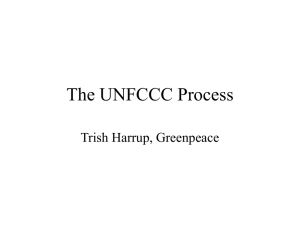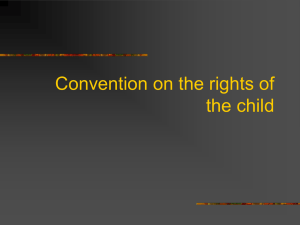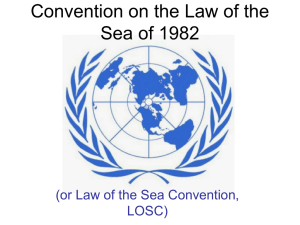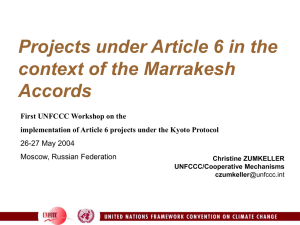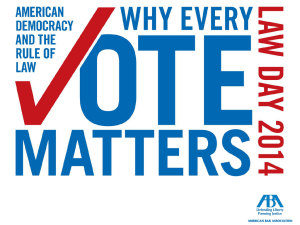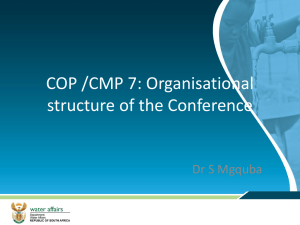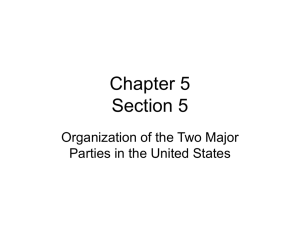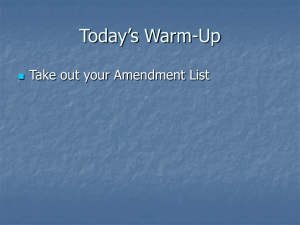UNFCCC Rules of Procedure - Legal Response Initiative
advertisement
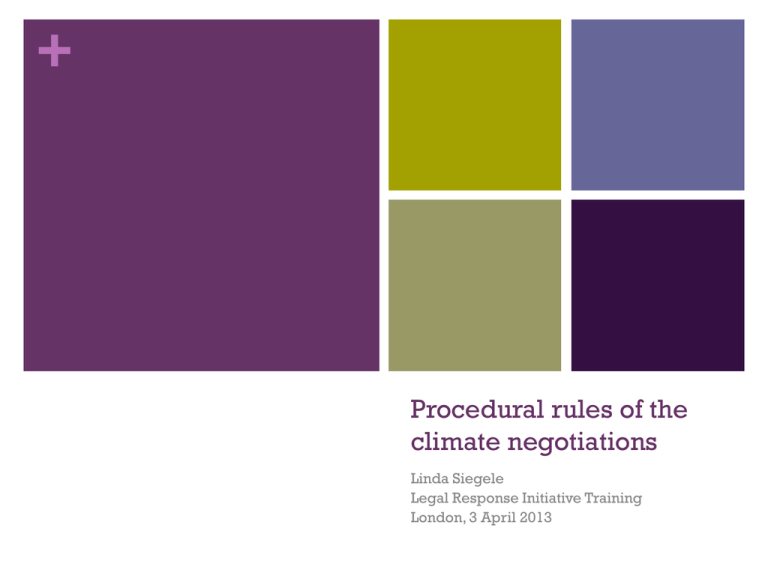
+ Procedural rules of the climate negotiations Linda Siegele Legal Response Initiative Training London, 3 April 2013 + Today’s outline Introduction to the Rules of Procedure Specific issues Informal approaches outside the rules Practice and operation of other international convention processes Finding decisions and documents Drafting decision text and interventions Use of standard terminology and progressing contentious issues Exercise – using the rules of procedure + UNFCCC Rules of Procedure – a brief history Where do we find them? Draft Rules of Procedure (FCCC/CP/1996/2) Convention and Kyoto Protocol (KP) texts Draft Rules of Procedure "the Conference of the Parties shall, at its first session, adopt its own rules of procedure as well as those of the subsidiary bodies established by the Convention ... .” (UNFCCC, Article 7.3) The rules of procedure are to include decision-making procedures for matters not already covered in the Convention The rules of procedure remain in draft because Parties are unable to agree on the voting rule (Rule 42) but are ‘applied’ at each session The Draft Rules of Procedure applied to CMP (KP) sessions as well (KP Article 13.5) Permanent committees et al operate under their own rules of procedure, e.g. CDM Executive Board, Technology Executive Committee, Adaptation Fund Board + Structure and content of rules of procedure I. Scope Rule 1 II. Definitions Rule 2 III. Place of sessions Rules 3 IV. Dates of sessions Rules 4 and 5 V. Observers Rules 6 – 8 VI. Agenda Rules 9 – 16 VII. Representation and credentials Rules 17 – 21 VIII. Officers Rules 22 – 26 + Structure and content of rules of procedure IX. Subsidiary bodies Rule 27 X. Secretariat Rules 28 and 29 XI. Conduct of business Rules 30 – 40 XII. Voting Rules 41 – 53 XIII. Languages Rules 54 – 56 XIV. Sound records of the sessions of the Conference of the Parties Rule 57 XV. Amendments to rules of procedure Rule 58 XVI. Overriding authority of the Convention Rule 59 + Agenda (Rules 9 – 16) Provisional agenda distributed at least 6 weeks before meeting, including items proposed by Parties. (Rules 10(d) and 11) Parties can propose additional items to be added to a supplementary provisional agenda before the meeting opens. (Rule 12) The COP may add, delete, defer or amend items when adopting the agenda. Parties may request to include additional items at this time. Only items which are considered urgent and important may be added. (Rule 13) Where there is no consensus on how to include an item in the agenda, it is held in abeyance and included in the agenda of the next meeting unless the COP decides otherwise. (Rules 13 and 16) + Duties of the Conference President (Rule 23) Declare the opening and closing of the session; Preside at the meetings of the session; Ensure the observance of the rules; Accord the right to speak; Put questions to the vote and announce decisions; Rule on points of order; Have complete control of the proceedings and over the maintenance of order; May propose the closure of the list of speakers; May propose the limitation on time to be allowed to speakers and on the number of times each representative may speak on a question; The adjournment or the closure of the debate and the suspension of the adjournment of a meeting. + The Bureau (Rule 22) Eleven elected members (2 from each of the 5 regional groups PLUS one from SIDS). President Seven vice-presidents Chairmen of the subsidiary bodies Rapporteur Bureau members serve for one year with the possibility of being elected for a second year, but limited to no more than two consecutive terms. Mainly responsible for questions of process management. + Representation and credentials Parties participating in a session are represented by a delegation consisting of a head of delegation and other accredited representatives. The delegation’s credentials must be submitted 24 hours after the opening of a session. The Bureau examines the credentials and submits a report to the COP. Each Party has one vote. + Points of order / motions (Rules 34 – 40) A representative may raise a point of order at any time if the President has not followed the rules of procedure. (Rule 34) The President rules on a point of order immediately. The representative may appeal and have the ruling put to a vote. (Rule 34) A representative may make a motion calling for a decision on the competence of the COP to discuss any matter or to adopt a proposal or an amendment to a proposal submitted to it. (Rule 35) Motions to suspend or adjourn meetings or to adjourn or close the debate on the question under discussion can be spoken to by the proposer, another in favour and two against, before a vote. (Rule 38) A point of order is procedural in nature; a motion can be procedural or substantive and can be made in writing. + Proposed amendments, annexes, or protocols Must be communicated to Parties at least six months before the session where they are proposed for adoption. Draft Rules of Procedure 37 AND UNFCCC articles 15(2), 17(2) KP article 20(2) + Voting Procedural matters are decided by a majority of the Parties present and voting. There is no agreement on a voting rule for substantive matters. This means that consensus is still required for all substantive matters. Draft Rules of Procedure 42(1), Alternatives A and B This lack of agreement means that the rules of procedure remain in draft BUT are ‘applied’ at each session, primarily because all other rules have been agreed. + Rule 42(1) – Alternative A 1. The Parties shall make every effort to reach agreement on all matters of substance by consensus. If all efforts to reach consensus have been exhausted and no agreement has been reached, the decision shall, as a last resort, be taken by a twothirds majority vote of the Parties present and voting, except: (a) as otherwise provided by the Convention, the financial rules referred to in Article 7, paragraph 2 (k) of the Convention or the present rules of procedure[.] [;] [(b) for a decision to adopt a proposed protocol, which shall be taken by [consensus] [a three-fourths majority of the Parties present and voting][.] [;] [(c) for decisions under paragraph 3 of Article 4 and paragraphs 1, 3 or 4 of Article 11 of the Convention, which shall be taken by consensus.] + Rule 42(1) – Alternative B 1. Decisions on matters of substance shall be taken by consensus, except that decisions on financial matters shall be taken by a two-thirds majority vote. + Voting under the Convention and the KP Amendments to the agreement UNFCCC Article 15 – Amendments to the Convention KP Article 20 (Amendments) Adoption and amendment of annexes UNFCCC Article 16 – Adoption and amendment of annexes to the Convention KP Article 21 (Annexes) -make every effort to reach agreement by consensus, but where consensus cannot be reached, amendments may be adopted by a 3/4 majority vote of the parties present and voting- + Recent examples of the use of rules of procedure Amendments New agenda items Mexico / PNG proposal on voting amendment Amend UNFCCC articles 7 and 18 – allowing decisions of the COP to be made by a ¾ majority SBSTA 34 – Bonn (by numerous Parties) COP 17 – Durban (by India on equity, IPRs and trade) Points of order / objections COP 15 – Copenhagen Accord (no agreement) COP 16 – Cancun Agreements (agreement) COP 18 – Doha Climate Gateway (agreement) + Informal approaches outside the rules, e.g. Applying rules of procedure to all inter-sessional meetings Agenda items added by way of COP decisions Inclusion of observers in non-plenary sessions Determining consensus Chairing working groups and other informal groups + Practice and operation of other international convention processes UNFCCC Draft Rules of Procedure were based on those of Basel Convention Basel, Copenhagen and Rotterdam Conventions conduct joint meetings BUT maintain their own rules of procedure The voting provisions for the CBD’s rules of procedure are also contested, but all other rules have been adopted UN General Assembly requires a 2/3 majority vote on important questions (e.g. peace and security; Security Council membership; admission of new members) – otherwise a simple majority of those present and voting Montreal Protocol (to the Vienna Convention) requires a 2/3 majority of those present and voting for matters of substance but only a simple majority on procedural matters + Documents to keep in mind Annotated provisional agenda Note from the Chair Draft negotiating text Compilation of parties’ submissions Expert reports Non-papers + Finding decisions and documents UNFCCC website Search engine (and other sidebars) Meetings webpages Agendas Reports Daily programme Other (including workshops, schedule of meetings, etc) + Document symbols FCCC/AWGLCA/2010/MISC.2/Add.1 Organ group (FCCC) Subsidiary body or working group (AWGLCA) Year or session (2010) Nature (MSIC) Number (.2) Modifications (Add.1) + Drafting decision text and interventions – general context What are your government’s / regional group’s policies and objectives on the issue? How is the national position articulated? What options are available? + Hierarchy of documents Treaties Decisions Interpretation and expansion of treaty provisions Conclusions Legally binding agreement among States Written expression of agreed meeting outcomes Other (e.g. workshop reports, technical papers) + Negotiation Text Agreements usually consist of: The Title The Puts the operative part in context No binding legal value Used to guide interpretation of binding paragraphs, or to strategically include language The Preamble (“Recalling…”; “Noting…”) Operative Part (or “Decision Text”) Represents the actual “agreement” between Parties Prevails in direct conflict with preambular language Where ambiguous, preambular language used to interpret the Parties’ intention + Drafting – where to start Past decisions on similar or complementary subjects Conclusions from inter-sessional meetings Chair’s text Other UN resolutions Suggestions from stakeholders? (e.g. NGOs and other stakeholder groups) + The Importance of Diction “Scaled up predictable, new and additional, and adequate funding shall be provided to developing country Parties…” May: permissive and discretionary Should: not required but advised Shall, Will, Must: almost always binding unless combined with a weaker word, e.g. “shall endeavour” And: all connected clauses or provisions must be satisfied Or: only one of the connected clauses or provisions must be satisfied + Qualifying Language As appropriate / If necessary: gives states discretion To the extent feasible / practicable: to take action within limits set by the Party taking action Consider: Think about further without necessarily making a decision Towards: allows approximating a goal without getting there Organize a workshop: often used as a fallback when agreement can’t be reached, and usually a delay mechanism See Fry, I., Pacific Islands Negotiations Manual (2003) + Qualifying Language “The Parties decide to request that the secretariat organize a workshop on the provision of scaled up funding to developing country Parties…” “Developed country Parties shall consider taking steps, as appropriate and to the extent practicable, towards scaled up…funding for developing country Parties.” + Decision 2/CP.17, paragraph 83 Defines a new market-based mechanism, operating under the guidance and authority of the Conference of the Parties, to enhance the cost-effectiveness of, and to promote, mitigation actions, bearing in mind different circumstances of developed and developing countries, which is guided by decision 1/CP.16, paragraph 80, and which, subject to conditions to be elaborated, may assist developed countries to meet part of their mitigation targets or commitments under the Convention; + Decision 2/CP.17, paragraph 83 Defines a new market-based mechanism, operating under the guidance and authority of the Conference of the Parties, to enhance the cost-effectiveness of, and to promote, mitigation actions, bearing in mind different circumstances of developed and developing countries, which is guided by decision 1/CP.16, paragraph 80, and which, subject to conditions to be elaborated, may assist developed countries to meet part of their mitigation targets or commitments under the Convention; + Decision 7/CP.17, paragraph 5 Appreciates the need to explore a range of possible approaches and potential mechanisms, including an international mechanism, to address loss and damage, with a view to making recommendations on loss and damage to the Conference of the Parties for its consideration at its eighteenth session, including elaborating the elements set out in decision 1/CP.16, paragraph 28(a–d); + Decision 7/CP.17, paragraph 5 Appreciates the need to explore a range of possible approaches and potential mechanisms, including an international mechanism, to address loss and damage, with a view to making recommendations on loss and damage to the Conference of the Parties for its consideration at its eighteenth session, including elaborating the elements set out in decision 1/CP.16, paragraph 28(a–d); + Process Conference room paper (CRP) Oral intervention with written submission for inclusion in Chair’s text or non-paper in-session documents containing new proposals or outcomes of in-session work Written submissions from Parties are usually miscellaneous documents (MISC) Sharing / building consensus with interested parties + Making an Intervention Types of interventions (oral statements) Points of order: If you believe the Chair has not followed the rules of procedure “I would like to make a point of order.” Motions: Input on how the Chair should deal with an issue (procedural or substantive) “I would like to make a motion.” Can deflect attention from substantive issues Presenting Country/Bloc Position + Presenting Country/Regional or Political Group Positions 1) Raise your country flag and wait to be called 2) Acknowledge the President/Chair “Thank you Madame Chair.” 3) Associate with a larger group or announce that you’re speaking on behalf of a larger group “Madame Chair, I would like to associate myself with the remarks made by” / “I present the following remarks on behalf of…” 4) Remain positive and remark on positive aspects of the negotiation Adapted from Fry, I., Pacific Islands Negotiations Manual (2003) + Presenting Country/Regional or Political Group Positions 5) Make a clear, concise, and focused statement “Madame Chair, my intervention will be brief. My delegation would simply like to highlight two concerns…” 6) Diplomatically offer a different viewpoint to other interventions “Madame Chairman, my colleague from Germany has eloquently raised some very important points…However, one area where her approach might prove problematic is…” 7) Conclude by suggesting your view is most reasonable 8) Thank the Chairman Adapted from Fry, I., Pacific Islands Negotiations Manual (2003) + Negotiating Strategy Creating Bargaining Power To create bargaining power, you will need something to bargain with Highlight your assets and disadvantages Assets which others want to have or preserve Disadvantages which others feel responsible for or are obligated to do something about Form coalitions + Negotiating Strategy Advantages of Coalitions Decrease the number of negotiating groups Increase leverage and reduce transaction costs for smaller developing countries Can advance overlooked points of view Disadvantages of Coalitions Difficult to move between coalitions Consensus within a coalition may be difficult Difficult to shift away from consensus once formed + Integrative Bargaining Distributive (zero-sum) vs. Integrative Bargaining Integrative Bargaining (Package Building): Tends to favour pro-active Parties who link issues Parties make concessions in different areas but reach a combined result satisfactory to all Strategies include: broadening the issues or goods under discussion offering concessions on the side trading off lower priority issues + Package Building Key steps in building negotiation packages: 1) Finding the Ripe Moment These often come during a mutually hurting stalemate or a recent or impending catastrophe Follow the negotiations and have informal discussions with other negotiators While you have bargaining power, don’t give in too early Agreements exhaustion” are sometimes reached through “negotiation by + Package Building 2) Forming the Core Group A small group of key parties usually lays down the issues that are part of the package Make it known that you are speaking for on behalf of a coalition Indicate (informally) to other key Parties that you may have some solutions 3) Find Tradeoffs Tradeoffs which aim to give something to everyone, are key to obtaining broad agreement + Package Building Traps Watch out for: 1) Sequential Packaging Some Parties will try to build a package sequentially and address the things they want first 2) Unrealistic Offers Some Parties will make offers they know are completely unacceptable to other Parties “We tried” + Exercise – ADP outcomes Background Decision 1/CP.17 Launches a process to develop a protocol, another legal instrument or an agreed outcome with legal force under the Convention (ADP) Establishes the Ad hoc Working Group on the Durban Platform for Enhanced Action (ADP) ADP to complete its work no later than 2015 Protocol, another legal instrument or an agreed outcome with legal force to come into effect in 2020 Launches a workplan on enhancing mitigation ambition to identify and to explore options for a range of actions that can close the ambition gap + Exercise – Durban Platform outcomes (ADP) Legal form New protocol Amendment or Annex to the Convention / KP Outcome with legal force Objectives and principles Same? New? Adoption of the outcome See e.g. decisions 1/CP.3 and 1/CMP.8
